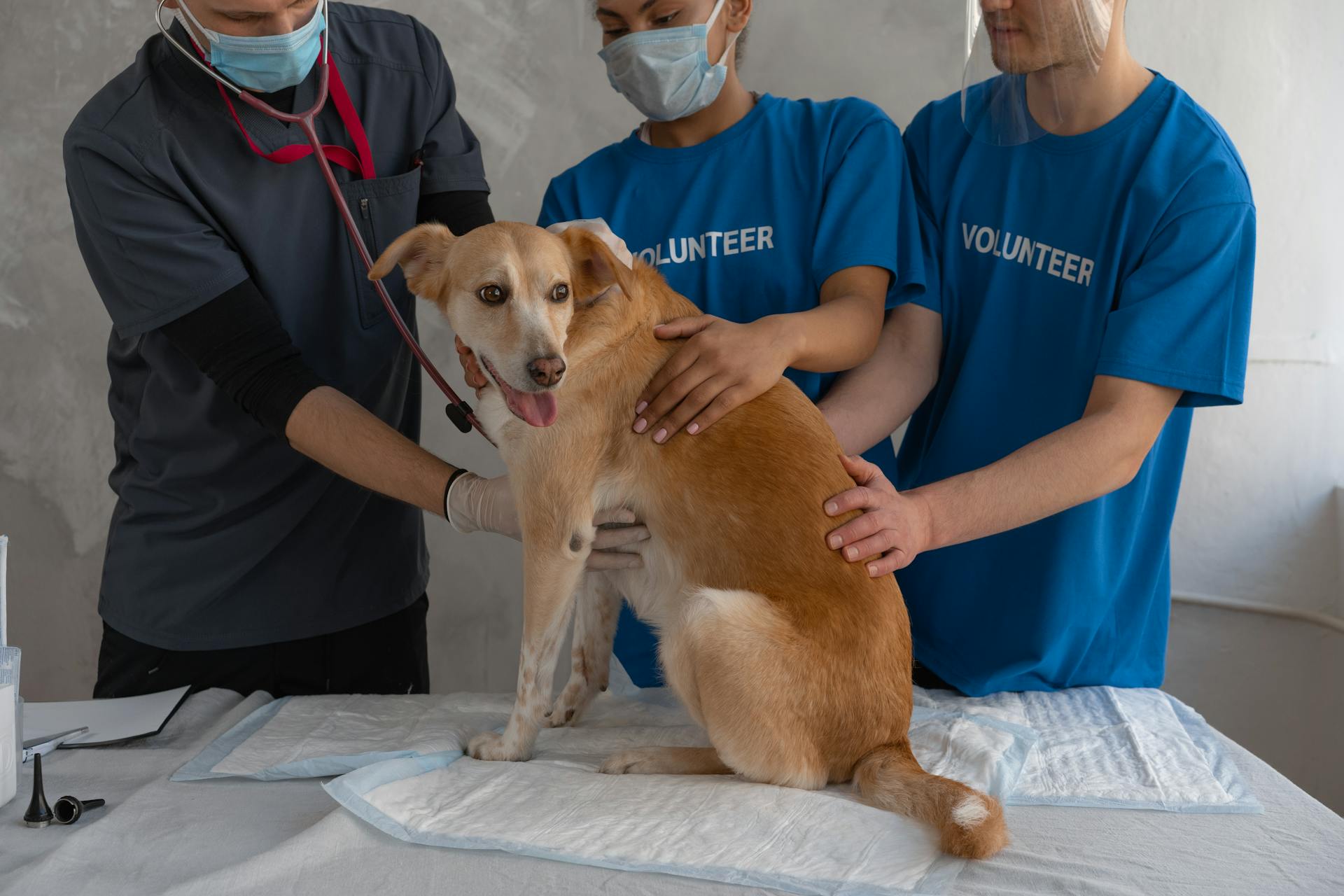
Canine distemper is a serious and highly contagious disease that affects puppies, causing a range of symptoms that can be heartbreaking for pet owners.
Puppies infected with canine distemper typically start showing symptoms within 7-14 days after exposure to the virus, which is usually through contact with an infected dog's saliva, urine, or feces.
One of the first signs of canine distemper in puppies is a high fever, which can range from 104°F to 106°F (40°C to 41°C). This is often accompanied by a loss of appetite and lethargy.
Puppies with canine distemper may also exhibit a thickening of the nasal discharge and a cough, which can progress to pneumonia if left untreated.
Explore further: Dog Diseases That Start with C
What is Canine Distemper?
Canine Distemper is a highly contagious and potentially deadly virus that affects dogs worldwide. It's caused by a virus that attacks a dog's respiratory, gastrointestinal, and nervous systems.
The virus is spread through contact with an infected dog's saliva, mucus, or other bodily fluids, which can be transmitted through direct contact, airborne particles, or contaminated food and water.
Recommended read: Canine Distemper Infection
Virology
Canine distemper is caused by a single-stranded RNA virus. This virus belongs to the family Paramyxoviridae.
The virus that causes distemper is a very close relative of the viruses that cause measles in humans and rinderpest in animals.
Background
Canine Distemper is a viral disease that affects dogs. It's caused by a virus that attacks the immune system and can lead to a range of symptoms.
The virus is highly contagious and can be spread through direct contact with an infected dog's saliva, mucus, or feces. This can happen through touching, licking, or even breathing in the virus.
Canine Distemper is a serious disease that can be fatal if left untreated. It's most common in puppies and unvaccinated adult dogs.
Symptoms and Stages
Symptoms of canine distemper in puppies can be quite varied, but they usually start with a watery to pus-like discharge from their eyes, followed by fever, loss of appetite, and clear nasal discharge.
The initial symptoms can also include lethargy, coughing, vomiting, diarrhea, and pustular dermatitis, which is a rare symptom. A secondary bacterial infection can also occur, leading to respiratory and GI symptoms such as vomiting, diarrhea, difficulty breathing, and pneumonia.
As the disease progresses, puppies may develop neurological signs, including head tilt, circling, partial or full paralysis, seizures, nystagmus, muscle twitching, and convulsions with increased salivation and chewing motions.
Here are some common symptoms of canine distemper in puppies:
- Fever
- Clear nasal discharge
- Purulent eye discharge
- Lethargy
- Coughing
- Vomiting
- Diarrhea
- Pustular dermatitis (rarely)
- Neurological signs (such as head tilt, circling, and seizures)
What Are the Symptoms?
The symptoms of distemper in dogs can be quite varied and depend on the severity of the case.
Fever is one of the first symptoms to appear, usually within 3-to-6 days after infection. Most dogs develop a fever, but the initial symptoms can depend on the individual dog's reaction to the disease.
Clear nasal discharge is another common symptom, often accompanied by watery to pus-like discharge from the eyes. Lethargy, coughing, vomiting, and diarrhea are also early signs of distemper.

As the disease progresses, some dogs may develop neurological signs, including head tilt, circling, partial or full paralysis, seizures, and nystagmus. These symptoms can be particularly disturbing for owners.
In addition to these symptoms, secondary bacterial infections can cause respiratory and GI symptoms, including vomiting, diarrhea, difficulty breathing, and pneumonia.
Here are some common symptoms of distemper in dogs:
- Fever
- Clear nasal discharge
- Purulent eye discharge
- Lethargy
- Coughing
- Vomiting
- Diarrhea
Some dogs may also experience hard pad disease, which causes the pads of their feet to harden and enlarge, leading to discomfort. Enamel hypoplasia is another lasting symptom, which can cause damage to the enamel of the dog's teeth.
Outcome
The outcome of a CDV infection can be severe, especially for puppies. Puppies experience the highest mortality rate due to complications like pneumonia and encephalitis.
In older dogs, distemper can lead to encephalomyelitis and vestibular disease. Around 15% of canine inflammatory central nervous system diseases are actually a result of CDV.
The mortality rate largely depends on the immune status of the infected dog.
See what others are reading: Canine Distemper Survival Rate
Disease Spread and Risk
Canine distemper is spread through direct contact or airborne exposure, much like the common cold in humans. This means that dogs can catch the disease by coming into contact with an infected animal or object, or by inhaling aerosol droplets released when an infected dog coughs, sneezes, or barks.
Wild animals like raccoons, foxes, wolves, coyotes, skunks, ferrets, and mink can also get distemper, putting dogs at risk for catching the disease. This is especially concerning if there's an outbreak of distemper in the local wildlife population.
Dogs aren't the only ones who can get distemper - unvaccinated dogs and puppies under 4 months old are particularly susceptible to the disease. If your puppy shows any symptoms of distemper, call your vet immediately.
Here are the ways canine distemper can be spread:
- Direct contact with an infected animal or object
- Airborne exposure
- Through the placenta
The good news is that the virus doesn’t last long in the environment and can be destroyed by most disinfectants.
History
The history of canine distemper is a long and fascinating one. The first report of the disease in Europe was in Spain in 1761.
Edward Jenner described the disease in 1809, but it wasn't until 1905 that French veterinarian Henri Carré determined that the disease was caused by a virus.
Carré's findings were initially disputed by researchers in England until 1926, when Patrick Laidlaw and G.W. Dunkin confirmed that the disease was, in fact, caused by a virus.
The first vaccine against canine distemper was developed by Italian Vittorio Puntoni in the early 20th century.
Host Range
Canine distemper is a highly contagious disease that affects a wide range of animal species.
The host range of canine distemper includes animals from various families and species, such as the red panda, dog, fox, wolf, and many others. Here's a breakdown of the affected families and species:
- Ailuridae (red panda)
- Canidae (dog, fox, wolf, Chinese raccoon dog)
- Elephantidae (Asian elephant)
- Felidae (large cats, though not domestic cats)
- Hyaenidae (hyena)
- Mustelidae (ferret, mink, skunk, wolverine, marten, badger, otter)
- Pinnipedia (seals, walrus, sea lion, etc.)
- Primate (some) (e.g., Japanese monkey, but not humans)
- Procyonidae (raccoon, coati)
- Ursidae (bear)
- Viverridae (raccoon-like South Asian binturong, palm civet)
Interestingly, domestic cats were once believed to be resistant to canine distemper, but recent research has shown that they can be infected, usually through close housing with dogs or blood transfusion from infected cats.
Broaden your view: Can Cats Get Canine Distemper
How Distemper Spreads
Distemper can be spread through direct contact with an infected animal or object. This can happen when you touch something that's been contaminated with the virus, like a food or water bowl.
The virus can also be airborne, which means it can spread through the air when an infected animal coughs, sneezes, or barks. This is similar to how the common cold spreads in humans.
Direct contact isn't the only way distemper can be spread. The virus can also be transmitted through the placenta, which is a part of the uterus that provides nutrients to a developing fetus.
Here are some examples of animals that can get distemper:
- Raccoons
- Foxes
- Wolves
- Coyotes
- Skunks
- Ferrets
- Mink
The good news is that the virus doesn't last long in the environment. It can be destroyed by most disinfectants, which can help prevent the spread of distemper.
Dogs at Risk
Any dog can get distemper, but unvaccinated dogs are particularly susceptible.
Puppies under 4 months old are also at high risk of contracting canine distemper.
If your puppy shows symptoms of distemper, you should call your vet immediately.
Diagnosis and Treatment
Diagnosis is a crucial step in treating canine distemper. Veterinarians diagnose distemper through a combination of clinical signs and diagnostic tests, or through a post-mortem necropsy.
The survival rate and length of infection depend on the strain of the virus and on the strength of the dog's immune system. Some cases resolve as quickly as 10 days, while others may exhibit neurological symptoms for weeks or even months afterward.
To confirm distemper, a definitive diagnosis can be made by finding the virus in the dog's conjunctival cells or footpads. This is especially true in unvaccinated dogs that display fever, respiratory signs, neurological signs, and thickened footpads.
If your puppy is showing symptoms of distemper, it's essential to bring them to a veterinarian immediately. Early medical intervention is integral in the survival rate of an animal with CDV.
Treatment for canine distemper is symptomatic and supportive, with a focus on treating fluid/electrolyte imbalances, neurological symptoms, and preventing secondary bacterial infections. This may include administering fluids, electrolyte solutions, analgesics, anticonvulsants, broad-spectrum antibiotics, antipyretics, parenteral nutrition, and nursing care.
Here are some common treatment methods used to support a puppy with distemper:
- Broad-spectrum antibiotics
- Pain relievers
- Seizure medications
- Electrolytes
- IV nutrition
- Fever reducers
- Hospitalization
- Immune system medications
- Anti-inflammatories
- Steroids
Mechanism
The canine distemper virus can spread through aerosol droplets and contact with infected bodily fluids, including nasal and ocular secretions, feces, and urine, 6 to 22 days after exposure.
It's a good idea to keep your dog away from other dogs that may be infected with the virus during this time. The time between infection and disease is 14 to 18 days, although a fever can appear from 3 to 6 days after infection.
This means that even if your dog doesn't show any symptoms right away, they can still be infected and contagious to others. The virus initially replicates in the lymphatic tissue of the respiratory tract, which can lead to a range of problems.
Typically, the virus enters the bloodstream on the second or third day after exposure and begins to cause damage to the respiratory, gastrointestinal, and nervous systems. A first round of acute fever tends to begin around 3–8 days after infection.
This can be accompanied by a low white blood cell count, especially of lymphocytes, as well as a low platelet count, and may or may not be accompanied by anorexia, a runny nose, or discharge from the eye.
Broaden your view: Schnauzer Ear Infection
Diagnosis
Diagnosis is a critical step in determining whether your dog has distemper. The signs of distemper, especially fever, respiratory signs, neurological signs, and thickened footpads, occurring in unvaccinated dogs strongly indicate CDV.
Several febrile diseases match many of the signs of distemper, making it difficult to diagnose. However, finding the virus by various methods in the dog's conjunctival cells or foot pads gives a definitive diagnosis.
A brush border slide of the bladder transitional epithelium of the inside lining from the bladder, stained with Diff-Quik, is an additional test to confirm distemper. These infected cells have inclusions which stain a carmine red color, found in the paranuclearcytoplasm.
In the early stages of distemper, about 90% of the bladder cells will be positive for inclusions.
Treatment
Treatment for canine distemper is purely supportive, as there is no known cure for the virus.
Veterinarians focus on treating the symptoms, such as diarrhea, vomiting, and neurological symptoms, to prevent dehydration and secondary infections.
To diagnose distemper, veterinarians use a combination of clinical signs and diagnostic tests, including biochemical tests and urine analysis.
Blood tests can reveal a reduced number of lymphocytes, a type of white blood cell, and urine analysis can detect viral antigens.
Veterinarians may also take swabs of a dog's throat, nose, and eyes, or collect samples from bone marrow, spinal fluid, or footpads to confirm the presence of the virus.
The treatment plan is tailored to each dog's specific needs, taking into account the strain of the virus, the dog's immune system, and the severity of the symptoms.
Treatment methods may include broad-spectrum antibiotics, pain relievers, seizure medications, electrolytes, IV nutrition, fever reducers, hospitalization, immune system medications, anti-inflammatories, and steroids.
Here are some of the treatment methods used to manage symptoms:
- Broad-spectrum antibiotics
- Pain relievers
- Seizure medications
- Electrolytes
- IV nutrition
- Fever reducers
- Hospitalization
- Immune system medications
- Anti-inflammatories
- Steroids
Frequently Asked Questions
What is the first stage of canine distemper?
The first stage of canine distemper is characterized by watery to pus-like eye discharge, fever, loss of appetite, and clear nasal discharge. This initial stage often precedes more severe symptoms if left untreated.
Sources
- https://www.akc.org/expert-advice/health/distemper-in-dogs/
- https://en.wikipedia.org/wiki/Canine_distemper
- https://www.merckvetmanual.com/dog-owners/disorders-affecting-multiple-body-systems-of-dogs/canine-distemper-hardpad-disease
- https://allkindsvet.com/canine-distemper/
- https://network.bestfriends.org/education/manuals-handbooks-playbooks/canine-distemper-playbook
Featured Images: pexels.com


